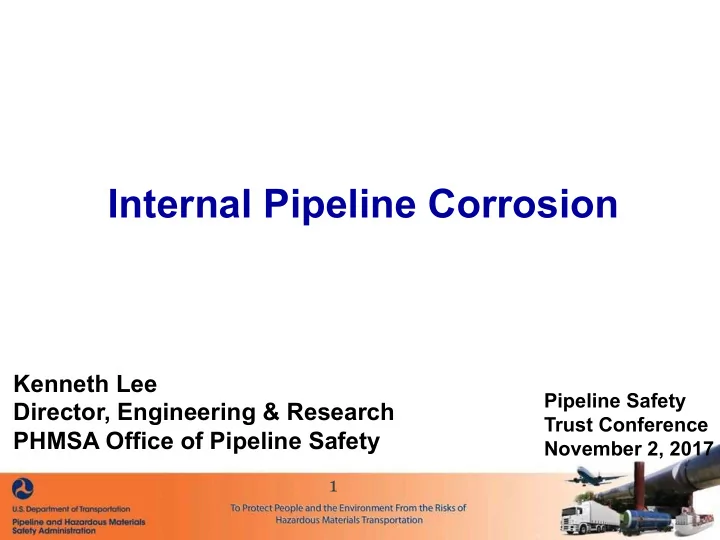

Internal Pipeline Corrosion Kenneth Lee Pipeline Safety Director, Engineering & Research Trust Conference PHMSA Office of Pipeline Safety November 2, 2017 1
Steel Pipeline Corrosion • Iron ore ⇒ Steel ⇒ Iron ore • Outside coated, inside usually bare • External corrosion prevention: – Coating – Cathodic protection • Internal corrosion prevention: – Controlling composition to ensure product is not corrosive 2
Internal Corrosion Drivers • Impurities: water, carbon dioxide, chlorides, hydrogen sulfide • Microbes (e.g. sulfate reducing bacteria) • Higher temperatures • Lower gas velocities (stagnant flow) 3
Hazardous Liquid Corrosion: 25% External: 11%, Internal 14% 4
Natural Gas Transmission Corrosion: 26% External: 9%, Internal: 17% 5
Natural Gas Distribution Corrosion: 3% Internal: 1%, External 2% 6
Gas Transmission Onshore Pipeline Significant Incident Rates per Decade 2005 - 2016 - Incidents per 1,000 Miles “Unknown and Pre-1940” decade leading cause is Corrosion “1940s” decade leading cause is Material Failure of Pipe or Weld “2010s” decade leading cause is Equipment Failure 7
Incidents: Internal Corrosion • 2000: Carlsbad, NM (gas transmission) – 12 fatalities • 2008: Pasadena, TX (petroleum) – 1 fatality, 5500 barrels released • 2013: Cushing, OK (crude oil) – 2250 barrels released • 2016: Franklin County, MO (petroleum) – 657 barrels released 8
Internal Corrosion Control • Controlling product quality composition • Minimizing stagnant flow • Liquids removal for natural gas pipelines • Inspection, monitoring, & alarms 9
Internal Corrosion Protection Methods • Cleaning Pigs/Tools • Inhibitors/Biocides/Other Chemical Additives • Control moisture and chemical content of products in pipeline • Inline Inspection (ILI) • Integrity Management 10
49 CFR 195 Hazardous Liquid • §195.4 Chemically compatible • Subpart H: Corrosion Control • §195.452: Integrity Management • §192.475 Internal Corrosion Control 11
49 CFR 192 Natural Gas • § 192.53 Chemically compatible • Subpart I: Corrosion Control • Subpart O: Integrity Management • §192.475 Internal Corrosion Control 12
§ 192.475 Internal corrosion control: General. (a) Corrosive gas may not be transported by pipeline, unless the corrosive effect of the gas on the pipeline has been investigated and steps have been taken to minimize internal corrosion. (b) Whenever any pipe is removed from a pipeline for any reason, the internal surface must be inspected for evidence of corrosion. If internal corrosion is found - (1) The adjacent pipe must be investigated to determine the extent of internal corrosion; (2) Replacement must be made to the extent required by the applicable paragraphs of §§ 192.485, 192.487, or 192.489; and (3) Steps must be taken to minimize the internal corrosion. (c) Gas containing more than 0.25 grain of hydrogen sulfide per 100 cubic feet (5.8 milligrams/m .3) at standard conditions (4 parts per million) may not be stored in pipe-type or bottle-type holders. 13
§ 192.476 Internal corrosion control: Design and construction of transmission line. (a)Design and construction. Except as provided in paragraph (b) of this section, each new transmission line and each replacement of line pipe, valve, fitting, or other line component in a transmission line must have features incorporated into its design and construction to reduce the risk of internal corrosion. At a minimum, unless it is impracticable or unnecessary to do so, each new transmission line or replacement of line pipe, valve, fitting, or other line component in a transmission line must: (1) Be configured to reduce the risk that liquids will collect in the line; (2) Have effective liquid removal features whenever the configuration would allow liquids to collect; and (3) Allow use of devices for monitoring internal corrosion at locations with significant potential for internal corrosion. ……….. [ 72 FR 20059, Apr. 23, 2007] 14
PHMSA Pipeline Safety Tools • Regulations • Inspections • Enforcement • Research 15
PHMSA Funded Research Courtesy: CRC Evens Courtesy: Pipetel Technologies Courtesy: LASEN Courtesy: ITT Kodak Guided Wave Ultrasonics Courtesy: Pure Gas/Liq Leak Technologies Leak Detection by Fixed Detection Wing/ Helicopter along pipeline 16 Remaining Strength Corrosion Models
Small Sample of PHMSA Research Projects • Development of EMAT Sensors for Corrosion Mapping of Unpiggable Natural Gas Pipelines Using ILI Tools • Establishing Remaining Strength of Line Pipe and Fittings with Corrosion Type Defects • Enhanced Mitigation of Pipeline Biocorrosion Using A Mixture of D-Amino Acids with A Biocide • Fundamental Mechanochemistry-based Detection of Early Stage Corrosion Degradation of Pipeline Steels 17
Thank you phmsa.dot.gov kenneth.lee@dot.gov 18 18
Recommend
More recommend